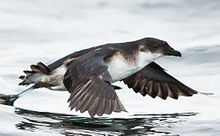Peruvian diving petrel
| Peruvian diving petrel | |
|---|---|

| |
| fledgling | |
| Scientific classification | |
| Domain: | Eukaryota |
| Kingdom: | Animalia |
| Phylum: | Chordata |
| Class: | Aves |
| Order: | Procellariiformes |
| Family: | Procellariidae |
| Genus: | Pelecanoides |
| Species: | P. garnotii
|
| Binomial name | |
| Pelecanoides garnotii (
Lesson, RP & Garnot , 1828) | |

| |
The Peruvian diving petrel (Pelecanoides garnotii) (local name in Peru: potoyunco) is a small seabird that feeds in offshore waters in the Humboldt Current off Peru and Chile.
Taxonomy
The Peruvian diving petrel was
Description
Peruvian diving petrel is 20–24 cm (7.9–9.4 in) in overall length. Like the rest of the diving petrels it is a nondescript bird, with a dark back and pale belly, and blue feet, and can be separated from the rest of its family only by differences in its beak and nostrils.[5]
Behaviour
Food and feeding
Unlike the
. The main part of his food is made up by plankton organisms (85.3-91.1%). The remaining percentage of the Peruvian diving petrel's food is fish, mainly anchovies. Peruvian diving petrels can dive up to 83 metres (270 ft) deep but the average depth was recorded at around 30 metres (100 ft). It was long thought that the Peruvian diving petrel was rather bad in flying. However, great numbers of birds have been observed fishing regularly in the area between Asia Island and Pachacamac Island at a distance of 150-200 kilometres north of their Peruvian breeding grounds.Conservation status
The Peruvian diving petrel has become locally extinct on many of its former colonies and now nests only on a few offshore islands. A total population of 12,216 breeding pairs was estimated for San Gallán and La Vieja Islands in Peru, with some small additional breeding colonies reported for Corcovado Island in Peru, as well as Pan de Azucar Island, Choros islands, Grande and Pajaros islands in Chile. They breed year round, laying a single egg in a burrow dug into guano.
Peruvian diving petrels are considered
References
- . Retrieved 20 November 2021.
- ^ Lesson, René P. (1828). Manuel d'ornithologie, ou Description des genres et des principales espèces d'oiseaux (in French). Vol. 2. Paris: Roret. pp. 394–395.
- ^ Lacépède, Bernard Germain de (1799). "Tableau des sous-classes, divisions, sous-division, ordres et genres des oiseux". Discours d'ouverture et de clôture du cours d'histoire naturelle (in French). Paris: Plassan. p. 13. Page numbering starts at one for each of the three sections.
- ^ Rasmussen, Pamela, eds. (January 2022). "Petrels, albatrosses". IOC World Bird List Version 12.1. International Ornithologists' Union. Retrieved 9 February 2022.
- ISBN 84-87334-10-5.
- Fernández, C.E.; Portflitt-Toro, M.; Miranda-Urbina, D.; Plaza, P.; Luna, N.; Luna-Jorquera, G. (2020). "Breeding abundance and population trend of the Peruvian diving-petrel Pelecanoides garnotii in Chile: Recovery of an endangered seabird?". Bird Conservation International. 30 (3): 423–433. .
- Jahncke, Jaime; Goya, Elisa (1998). "The status of the Peruvian diving-petrel population at its main breeding areas along the coast of Peru". Colonial Waterbirds. 21 (1): 94–97. JSTOR 1521739.
- Jahncke, J.; García-Godos, A.; Goya, E. (1999). "The diet of the Peruvian diving-petrel at la Vieja and San Gallan, Perú (La Dieta de Pelecanoides garnotii a la Vieja y San Gallan, Perú)" (PDF). Journal of Field Ornithology. 70 (1): 71–79. JSTOR 4514384.
- Romero, M. B. Valverde (2006). "First record of the endangered Peruvian diving petrel Pelecanoides garnotii breeding on Corcovado Island, Peru" (PDF). Marine Ornithology. 34: 75–76.
External links
- Species factsheet - Mundo Azul
- Species factsheet - BirdLife International

